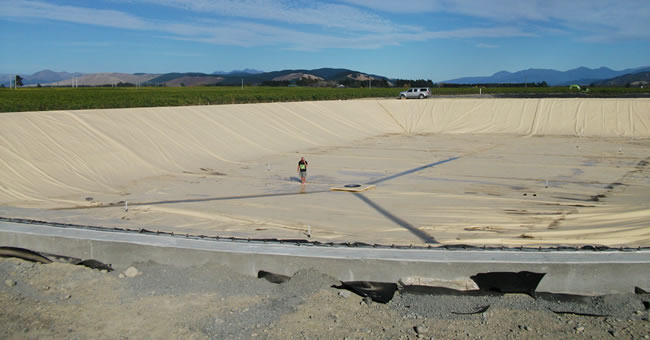February 18 is Drink Wine Day, which gives us an opportunity to look back at one of our favorite floating cover stories in Geosynthetica’s archives. Here, we look at a two wastewater ponds constructed at a winery in New Zealand. Originally published in June 2011.
New Zealand is well known for its wines and its environmental management. The upgrade of a Marlborough winery wastewater treatment system included two new 15-megalitre lagoons. One was a covered anaerobic system for untreated wastewater and the other was an uncovered storage system for treated wastewater.

WINERY WASTEWATER MANAGEMENT
Viking Containment was responsible for the design and supply of the liners and biogas collection floating cover. Phil Bennett of Geotest Australia designed a “Tension Plate” floating cover system to accommodate the fluctuating levels of the lagoon. The design included a biogas collection system beneath the cover and a stormwater dewatering system on top of the cover.
The cover material was a reinforced polypropylene (RPP) geomembrane. Cover panels were fabricated in Viking Containment‘s facility to predetermined dimensions and included attachment straps and float wrap sleeves to minimize onsite seaming.
RELATED: A Primer for HDPE Geomembrane Liners in Wastewater Lagoons – Avoiding Whales
The cover was installed with floats and ballast tubes in the correct geometry to maintain a tensioned cover. This tension eliminates cover slack at all levels of operation and provides effective drainage of stormwater from the top of the cover to the formed sumps. A central platform houses a submersible pump for stormwater dewatering.

Platforms, walkways and floats were constructed on site using closed cell polyethylene foam encapsulated in polypropylene.
Gas relief valves were installed in eight locations on the cover as a precaution in case of extraction failure or unexpected gas build up over-inflating the cover. Sampling ports were also incorporated into the cover to allow regular inspection, sampling, and testing.
All factory panels and onsite seaming was air pressure tested to ensure the cover was gas tight. For the cover perimeter, a mechanical batten bar and rubber gasket system sealed the cover to a concrete ring beam.
THE VALUE OF PREFABRICATED PANELS
The project completion date was critical to the operations of the winery, as processing of the pending harvest required the new storage capacity. The value of prefabrication was clear to the project’s success, as a material shipment delay put the installation program behind; but, the prefabrication of all the cover panels and foam sleeves allowed the site crew to expedite the installation, which made up for lost time.
The cover installation was completed in just 10 days.











